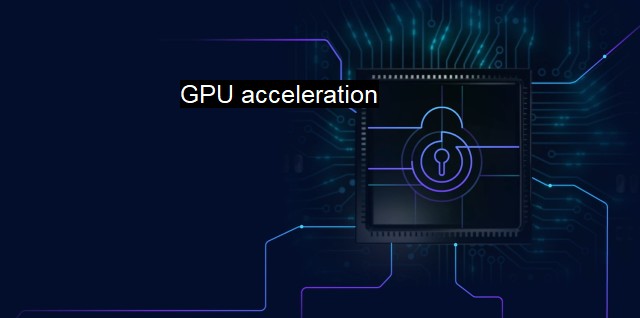What is GPU acceleration?
Powering Up Antivirus: How GPU Acceleration is Tackling Complex Cybersecurity Threats
GPU acceleration refers to the technique of using a computer's graphics processing unit (GPU) to execute tasks traditionally handled by the central processing unit (CPU). This method comes in handy especially when dealing with extensive and computational intensive tasks in cybersecurity and antivirus.A Graphics Processing Unit or GPU is designed to perform rapidly and efficiently compute operations, mainly for rendering images and video streaming. These capabilities are now being harnessed in the cybersecurity arena, where the power of GPU acceleration is used to enhance antivirus and malware protection programs. GPUs, which are essentially various types of computer hardware, are extremely efficient at manipulating computer graphics and image processing. The performance of a GPU far surpasses that of a CPU due to its parallel processing architecture, which allows it to execute multiple tasks simultaneously—an ability that's particularly handy when handling vast datasets, an increasingly common phenomenon in cyberspace.
GPU acceleration can be employed for pattern recognition tasks, such as scanning and analyzing data packets for anomalies or malicious activities. In the fight against viruses and malware, early detection is crucial, and the speed offered by GPU acceleration can greatly enhance the efficiency of this process. For instance, GPU-accelerated virus scanning can rapidly examine files for known malware signatures, while intelligent heuristics can identify unknown threats based on patterns of behavior.
The capability of GPUs to effectively perform mathematical operations means that they can conduct robust encryption and decryption actions. this function aids in the creation of secure communications channels, encryption of data, and thwarting attempts to crack passwords. GPUs are heavily involved in generating random numbers which are used in cryptography to ignite the encryption algorithms.
A compelling instance of realtime monitoring and malware detection leveraging GPU technology is securing Machine Learning (ML) algorithms. Its ability to fast-track computationally intensive tasks makes it exceptionally suited to carry out ML tasks which intend to identify and neutralize potential threats. Deep learning algorithms running on GPU-accelerated platforms can process and make sense of significant data volumes at high speed, spotting malware behavior and reacting quickly to neutralize threats.
It's crucial to mention, though, that while GPU acceleration has much to offer for cybersecurity and antivirus actions, it's not without its vulnerabilities. In 2017, for instance, cybersecurity experts discovered malware known as "Digmine" that manipulated the GPU to mine cryptocurrency on infected machines without the users’ knowledge. Hence GPUs might become as attractive to criminals as they are to cybersecurity personnel.
To summarize, GPU acceleration is a powerful tool that can significantly improve the functionality of cybersecurity applications in detecting and mitigating cyber threats. Given the landscape of rising cyber threats and an increasing load of data to analyze, the application of GPUs bringing speed and parallel processing capacity can enhance technology's response to cyber threats. But, at the same time, attention should be given to the potential vulnerabilities this trend may open, and efforts must be taken to secure GPU-accelerated platforms against abuse. Thus, both sides of the trend must be approached with full knowledge and utmost caution.

GPU acceleration FAQs
What is GPU acceleration in the context of cybersecurity and antivirus?
GPU acceleration in the context of cybersecurity and antivirus refers to the use of graphics processing units (GPUs) to offload computationally intensive tasks from the central processing unit (CPU) to improve the performance and efficiency of cybersecurity and antivirus software.What are the benefits of using GPU acceleration for cybersecurity and antivirus?
Using GPU acceleration in cybersecurity and antivirus can provide several benefits, such as faster malware detection and removal, improved threat analysis, and enhanced data processing capabilities. This can ultimately lead to better protection against cyber threats and a more efficient use of system resources.What types of tasks can be accelerated using GPUs in cybersecurity and antivirus?
GPU acceleration can be utilized for a range of tasks in cybersecurity and antivirus, including but not limited to, signature scanning, machine learning-based threat detection, and data analysis for network traffic monitoring. GPU acceleration can also be used for password cracking and encryption breaking, which can help in identifying and mitigating cyber attacks.Are there any downsides to using GPU acceleration in cybersecurity and antivirus?
The primary downside to using GPU acceleration in cybersecurity and antivirus is that it requires a compatible GPU and may not be supported by all software. Additionally, GPU acceleration can increase power consumption and generate more heat, which can impact system stability and longevity. However, with proper configuration and hardware considerations, the benefits of GPU acceleration can outweigh the downsides.| | A | | | B | | | C | | | D | | | E | | | F | | | G | | | H | | | I | | | J | | | K | | | L | | | M | |
| | N | | | O | | | P | | | Q | | | R | | | S | | | T | | | U | | | V | | | W | | | X | | | Y | | | Z | |
| | 1 | | | 2 | | | 3 | | | 4 | | | 7 | | | 8 | | |||||||